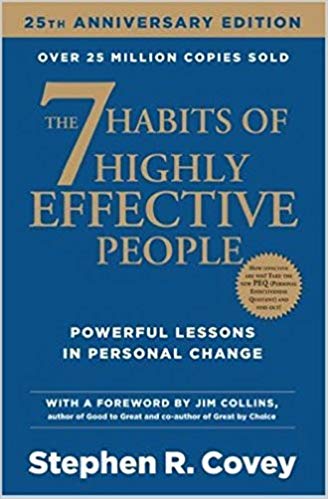

This article is an excerpt from the Shortform summary of "The 7 Habits of Highly Effective People" by Stephen Covey. Shortform has the world's best summaries of books you should be reading.
Like this article? Sign up for a free trial here .
Habit 5: seek first to understand, then to be understood tackles how to have an effective interaction with someone. The idea is this: first work on understanding the other person’s perspective, then help them to understand your perspective.
Only by working on covey’s habit 5: seek first to understand, then to be understood can you determine the kind of mutually beneficial solution that a Win/Win paradigm strives to achieve.
What is Habit 5: Seek First to Understand, Then to be Understood?
Generally, many aspects of interdependent situations are out of your control and in your Circle of Concern, including certain problems, circumstances, and other people’s actions. Habit 5: seek first to understand, then to be understood focuses on acting within your Circle of Influence — understanding the other person and expressing yourself. Those actions, in turn, can help you effectively influence other people, which can influence situations that impact you, which expands your Circle of Influence.
Communication is a critical aspect of productive interpersonal relationships. When truly effective interdependent people communicate, they first try to understand the other person’s perspective before expressing their own. On a larger scale, this principle holds true in many professions.
There are four forms of communication: speaking, listening, reading, and writing. Despite all the training and education we get to learn how to speak, read, and write well, we receive very little instruction on effective listening.
The listening techniques we do learn tend to fall in the Personality Ethic, without setting up the paradigms for the necessary character-based foundation that allow us to seek to understand before being understood. Techniques provide the skills, but you also need the genuine desire to understand other people, work together, and develop Win/Win solutions; in order to have productive relationship in which you can work with and influence another person, you must first understand them. This is what covey’s habit 5: seek first to understand, then to be understood means.
Seek First to Understand, Not to Respond
We discussed in Habit 4 that an essential step in reaching a Win/Win solution is to try to understand the other person’s perspective and concerns. The key to truly understanding people is empathic listening, which is listening with the intent to see their perspective. Empathetic listening is necessary to work on habit 5: seek first to understand, then to be understood.
When a friend comes to you with an issue he’s having, how often do you respond with a story about your own similar experience and what you did to resolve it? Or how commonly are you met with this kind of response when you are venting to someone else? Are you attempting to seek to understand before being understood? Think about interactions you may have had like this. Can you think of any other seek first to understand then to be understood examples from your relationships?
Although well-intended, this response offers a solution without really trying to understand the problem or that individual’s perspective. It can cause the first person to be reluctant to share more because they don’t feel understood, and she may be even more reluctant to take any advice offered: How can they trust your advice if it’s not coming from a place of actually understanding the problem?
We do this all the time in communication — prescribing a solution before diagnosing the problem — but think of how ridiculous this response would be in another context. When you do this, you’re ignoring the principles of habit 5: seek first to understand, then to be understood.
Here is one seek first to understand then to be understood example. Imagine you go to the eye doctor because you’re having trouble with your vision. You start to explain your problem to the optometrist, and she quickly takes her own glasses off her face and tells you to try them on. The glasses do nothing to help your vision, but when you tell the doctor this, she insists that the glasses work perfectly for her, so they should work for you too; she tells you to try harder. As hard as you try, the glasses still don’t help your vision.
Empathy is Crucial for Habit 5: Seek First to Understand
Often people listen in order to reply, and their responses are based more on their own experience and interpretation than what the other person is saying. Habit 5: seek first to understand, then to be understood means shifting this paradigm. People typically listen in one of four ways:
- Ignoring: In this case, you’re really not listening to the other person.
- Pretending: This is when you give automated responses like “right” or “absolutely” at the appropriate cues, but you’re not actually listening.
- Selective Listening: You’re only listening to pieces of what the other person is saying, as we tend to do when small children are going on incessantly.
- Attentive Listening: You’re listening closely to everything the person is saying.
None of these is sufficient for truly understanding.
Empathic listening is the fifth form of listening; empathic listening goes beyond attentive listening, because you’re not only hearing every word but also listening with an effort to understand the other person’s paradigm. In other words, you’re trying to seek to understand before being understood.
When we fail to listen empathically — from the other person’s perspective — we listen autobiographically, interpreting everything through our own lens and experiences. Autobiographical listening tends to yield one of four responses.
- Evaluate: You determine sides and agree or disagree. You are jumping to decisions without fully understanding the situation, which robs the person of the emotional space she needs to process a problem.
- Probe: You ask questions based on your interpretations and experiences, and not based on what the person is saying. This controls the conversation and is invasive to the other person without getting you any closer to understanding; probing often creates communication barriers between parents and children (e.g. “How was school?” “Fine.” “What did you learn?” “Stuff.” “What’s wrong?” “Nothing.”). This approach also uses left-brained logic for the right-brained task of understanding emotion.
- Advise: You offer advice on what to do and how to fix the problem, prescribing before diagnosing.
Interpret: You try to figure out the person’s motives and behaviors based on how you would act in that situation; this is different than trying to understand the other person’s perspective. Habit 5: seek first to understand, then to be understood, allows you to truly learn how to listen.
Empathetic Listening is Crucial for Productive Interactions
First, it gives you the most useful information to work with as you interact with the other person because you’re getting an accurate picture of how this person views and feels about a situation, as opposed to your own skewed interpretation of it. Just as with any problem, you need accurate data to reach an effective solution.
Second, when people recognize that you’re genuinely trying to understand them, they’ll be more inclined to trust you and open up further, and your effort will make a big deposit in your Emotional Bank Account. In this way habit 5, seek first to understand, then to be understood, furthers your goals of connecting with others.
Third, empathic listening gives a person “psychological air,” the figurative space she needs to process a problem. To understand this, imagine all the air was sucked out of the room and you couldn’t breathe; you wouldn’t be able to focus on anything but your ability to breathe and survive. Similarly, if you don’t have air for your psychological survival — which includes being understood, affirmed, validated, and appreciated — you can’t focus on any other efforts like problem solving. Just like in a survival situation, you might begin acting frantically and illogically, trying anything you can to gasp for air.
Understanding and validating someone gives them psychological air to be able to move forward and work through a problem. Once they feels heard and understood, their more inclined to hear your perspective, and then you two have the groundwork from which you can reach a solution.
The Four Stages of Empathetic Listening
In order to use habit 5, seek first to understand then to be understood, you must use true empathic listening. True empathic listening stems from a paradigm that includes a genuine desire to understand other people; from that foundation, there are skills you can practice to master empathic listening.
- The first stage is mimicking, often called “active” or “reflective” listening, which involves repeating a person’s words back to her. Mimicry gets you into the practice of attentive listening, and avoiding any autobiographical responses. But it’s not very effective beyond that because you’re only repeating — not processing — what she’s saying.
- The second stage is rephrasing the content, which at least requires you to process what you’re hearing, but still limits your listening to verbal communication. Rephrasing requires you to think about what the person said, but you’re doing so through a left-brained, logical lens rather than an emotional one.
- In the third stage, reflect the feelings the person is expressing. This brings the right brain into play, and begins to understand the other person’s perspective. You’re focusing on more than the person’s words — you also include her emotions.
- The fourth stage integrates both the second and third stages, so that you’re rephrasing the content of what the person is saying and reflecting her feelings. This brings together the left and right sides of the brain to understand not just the words she’s saying but also the emotions she’s communicating.
When you practice empathic listening at the fourth stage, you show your desire to understand and give the person psychological air to further process what she’s feeling. Sometimes people just need to talk through their problems, and when they feel heard and understood, they have the psychological air to reach solutions on their own.
Empathetic Listening is The Key to Communication
In an interpersonal relationship, it’s just as important that you’re understood as it is that you understand the other person. To help the other person understand your perspective, you need to effectively express it.
The keys to effective communication are in the early Greek philosophy of ethos, pathos, and logos. Understanding the keys to communication will help you seek to understand before being understood, and see examples.
- Ethos has to do with your character and personal integrity. This determines how much people trust you, and is inextricably tied to your Emotional Bank Account.
- Pathos deals with feelings; you must be on the same page emotionally as the person you’re communicating with. To be on the same page, you need to first understand the other person’s feelings and perspectives, which requires empathic listening.
- Logos invokes logic, which is the information and reasoning for your perspective.
Ethos, pathos, and logos represent not only the different aspects of expressing your perspective, but also the order in which to carry them out. Many people start with logos, trying to make the logical argument for their case, but you’re more likely to get the other person to understand if you start from a foundation of principled character and a trusting, open relationship.
We all know how difficult communication can be. Covey’s Habit 5: seek first to understand, then be understood provides clear and actionable ways to be a better listener, and to apply those skills to business and personal relationships.
———End of Preview———

Like what you just read? Read the rest of the world's best summary of "The 7 Habits of Highly Effective People" at Shortform . Learn the book's critical concepts in 20 minutes or less .
Here's what you'll find in our full The 7 Habits of Highly Effective People summary :
- How to prioritize the hundred tasks you have to focus on the one or two that really matter
- The right way to resolve every disagreement and argument
- How to avoid burning out and succeed over 20+ years






